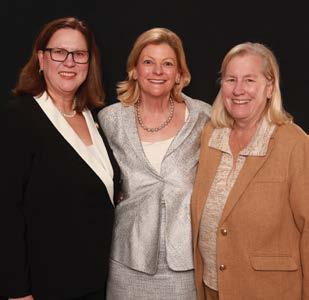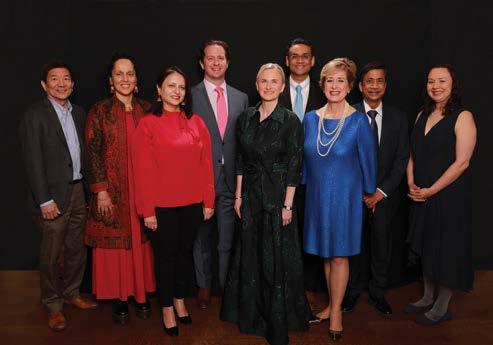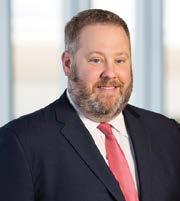


























Dallas County Medical Society Honors Community Leaders in Medicine







HOW A RADIOLOGIST AND A BILLIONAIRE ARE CHALLENGING THE PHARMACEUTICAL INDUSTRY PLUS











Jon R. Roth, MS,
EDITORIAL
EDITOR,
Lauren S. Williams
DESIGNED BY Morganne Stewart
Erin Roe, MD, MBA February
Michelle Caraballo, MD, Chair
Ravindra Mohan Bharadwaj, MD
Jawahar Jagarapu, MD
Ravina R. Linenfelser, DO
Sina Najafi, DO
Celine Nguyen, Student
Shyam Ramachandran, Student


Shaina Drummond, MD, President
Gates Colbert, MD, President-elect
Vijay Giridhar, MD, Secretary/Treasurer
Deborah Fuller, MD, Immediate Past President
Neerja Bhardwaj, MD
Justin Bishop, MD
Sheila Chhutani, MD
Philip Huang, MD, MPH
Nazish Islahi, MD
Allison Liddell, MD
Riva Rahl, MD
Anil Tibrewal, MD




















Shaina Drummond, MD
It is both an honor and a privilege to serve as the 142nd president of the Dallas County Medical Society (DCMS). Being entrusted with the responsibility of helping lead the secondlargest medical society in the country is deeply humbling. This year, DCMS celebrates a historic milestone: for the first time, three women will have served consecutively as president. This moment is not just a testament to progress but also a source of immense pride for our organization as we continue to break barriers and lead with purpose.
In preparation for my remarks this evening, I found myself reflecting on my own journey, and I began to struggle with feelings of imposter syndrome. Growing up in a single-parent home, I was primarily raised by my hardworking grandparents in Kansas. They instilled in me the values
of perseverance, kindness, and honesty—principles that have guided me throughout my life. As a first-generation college student, I worked my way through school with the help of grants, scholarships, and loans, just like many of you. While I am deeply grateful for this experience, I’ve sometimes felt that I lack the eloquence or political insight that so many of you possess. Looking back on my experiences growing up in Kansas, I’m reminded of a quote from Clint Eastwood in The Outlaw Josey Wales: “There are three kinds of suns in Kansas: sunshine, sunflowers, and sons of $@%#s!” Growing up in Kansas, I experienced all three. The sunshine instilled in me resilience, the sunflowers represented hope and beauty, and the third sun? Well, that helped me prepare for the challenges of navigating the Texas legislature!
The medical profession is undergoing a transformation as a new generation of physicians redefines the workforce and shifts priorities. Medical societies face a crucial question: How can we effectively attract and engage these emerging leaders? Many younger physicians feel disconnected from traditional organizations, often citing demanding schedules and a lack of relevance to their needs. This highlights the urgent need for organizations like DCMS to clearly demonstrate their value and adapt to these changing expectations.
As president, I’m committed to strengthening our connection with younger physicians by demonstrating how DCMS fosters meaningful relationships, supports professional growth, and prioritizes well-being through a vibrant community. Younger generations bring fresh perspectives and innovative ideas that help our association thrive. By bridging generational gaps and evolving our approach to professional development, we can ensure DCMS remains relevant, impactful, and inclusive. To meet the needs of the next generation, we’re enhancing our digital platforms, developing a more robust online career center, and providing more tailored resources for physicians in various practice models. We’re also introducing leadership programs, expanding networking opportunities, and creating spaces for connection through book clubs and social events. These efforts go beyond professional growth—they address burnout, build purpose, and make DCMS an essential resource for every physician, especially those in the younger generation.
As we enter 2025, DCMS is proud to celebrate milestones that signify our growth and progress. At the forefront is our transition to a modern, state-of-the-art building in Dallas’s thriving Uptown district. This centrally located headquarters not only enhances our ability to conduct the business of DCMS but also serves as the heartbeat of our organization—a dynamic space that will bring our members together, fuel collaboration, and amplify our collective impact on the medical community. It’s a place where members can host events, welcome distinguished speakers, and engage in meaningful meetings that drive our mission forward.
The excitement and enthusiasm at our recent open house are a clear reflection of the momentum surrounding this new chapter for DCMS— one that will create a lasting impact for our members and the community we serve. Building on this energy, we are transforming vision into action with initiatives that inspire the next generation, like partnering with local schools and DCMS physician volunteers to explore careers in medicine. Additionally, we are honoring our history by establishing a library and museum to preserve and showcase DCMS medical artifacts and historical documents.
I’m also excited to announce that enrollment is now open for the second year of the DCMS/UT Dallas Physician Leadership Certificate Program. This year-long program equips physicians with key leadership skills in wellness, value-based care, quality performance, IT innovations, and financial management, while adapting to industry trends.
DCMS remains committed to strengthening our partnerships with hospital systems and large group practices by continuing to offer cutting-edge CME topics, grand round series, and collaborative initiatives that enhance physician well-being and patient care. Our outreach to medical students and residents across the Dallas metroplex continues to grow, ensuring we support and inspire the next generation of physicians. These efforts reaffirm DCMS’s position as a driving force in healthcare, demonstrating our commitment to innovation, education, and community impact.
As we approach the 2025 legislative session in Texas, we face significant challenges that directly impact patient care. Ethical concerns and evolving laws—both state and local—are reshaping healthcare, with politics increasingly encroaching on the patient-physician relationship. The criminalization of medicine is eroding trust, autonomy, and security, making it harder for physicians to provide compassionate care. Addressing this issue requires a balance between accountability and recognizing the complexities of medicine.
While some physicians may feel that the Texas Medical Association (TMA) has not taken a firm enough stance on certain issues, we must remember that, regardless of political differences, our primary identity is as physicians. Our strength lies in unity, not division. We may not agree on everything, but we must set aside individual differences and focus on protecting the future of our profession. Together, we must prioritize the critical challenges that shape the foundation of healthcare in Texas, including scope of practice, women’s healthcare, Medicaid reform, access to care, physician autonomy, sustainability of the private practice mode, the role of AI in medicine, public health, vaccine policies, telemedicine parity, noncompete agreements, prior authorization reforms, and medical liability protections. By standing united on these issues, we can safeguard our profession and ensure that our patients receive the quality care they deserve.
DCMS is committed to collaborating with the TMA to ensure physicians play a leading role in shaping healthcare policy in Texas. If you are
concerned about the future of our healthcare system, now is the time to take action and advocate for meaningful change. Starting in February, DCMS will be mobilizing our physicians, medical students, and alliance members for TMA’s First Tuesdays at the Capitol in Austin, offering a powerful opportunity to unite and directly influence healthcare policy in Texas. No prior lobbying experience is required—the TMA will equip you with all the briefings and talking points you need to effectively advocate. As the healthcare landscape becomes more complex, it’s essential for lawmakers to hear firsthand about the challenges we face in delivering quality care. Put on your white coat and join us in Austin. Together, we can ensure a future of high-quality physician-led care, not corporate-driven agendas. Your involvement is vital to shaping the future of our profession.
As I close, I am reminded of Maya Angelou’s powerful words: “People will forget what you said, people will forget what you did, but people will never forget how you made them feel.” To our incredible DCMS staff, led by CEO Jon Roth, thank you for your unwavering dedication and creativity. You are the foundation of this organization, and it has been a privilege to work with such a passionate and supportive team. To the DCMS Board of Directors, your support and steadfast commitment to organized medicine has been an inspiration. Over the past six years, I’ve been honored to witness the exceptional leadership of past presidents, including Drs. Rick Snyder, Lee Anne Pearse, Kevin Klein, Mark Casanova, Beth Kassanoff-Piper, Sam Chantilis, Donna Casey, and our outgoing president, Dr. Deborah Fuller. Each of you has been a role model and a source of encouragement to me—thank you for your service.
I would like to extend a special heartfelt thank-you to Dr. Kevin Klein for his guidance and sponsorship throughout my journey with DCMS, and to Dr. Ray Callas, the current president of the TMA, for joining us this evening despite his demanding schedule. Dr. Callas is a well-respected physician leader in Texas. We are extremely fortunate to have his guidance and vision steering organized medicine in Texas.
To my colleagues at UTSW and Parkland, your support over the past 12 years has meant the world to me. You are not just colleagues but dear friends. And to my amazing family—Jonathan, Olivia, Christian, and Lilly—your love and encouragement are my strength. No matter how many roles I take on, being a wife and mother will always be the most important.
Finally, to all the DCMS members here tonight—thank you. Your dedication and commitment exemplify the excellence, compassion, and integrity that define our profession. It is a privilege to serve alongside such an extraordinary group of physicians.
Let’s make 2025 a year to reignite our passion for medicine and celebrate the privilege of working in the most rewarding profession in the world. Together, we can shape a brighter future for healthcare and for those we are so fortunate to serve. DMJ





































At Broadway Bank, we understand that access to the right medical equipment is critical for providing top-notch care. Our flexible loan options are designed to get you the equipment you need—when you need it.
• Quick and Easy Application Process: Our streamlined application process is designed to get you funds quickly, so you can focus on growing your business.
• Flexible Repayment Options: We offer a variety of repayment plans to suit your cash flow, making it easier to manage your financial obligations.
• Local Expert Support: Our team of experts is here to guide you every step of the way, providing personalized service and support to help you make the best financial decisions for your business.
Contact us today to learn more about our equipment loan options and discover how we can help take your business to the next level.
broadway.bank/health • (214) 227-7063


Jon R. Roth, MS, CAE
IN THE DEMANDING WORLD OF MEDICINE, THE recognition and celebration of individual achievements and awards are not merely ceremonial gestures, but essential practices that foster a thriving professional environment. As the DMJ managing editor and CEO of DCMS, I have had the privilege of observing the profound impact that acknowledging the successes of both physicians and the individuals who support them and advance public health can have on the entire community.
One of the most immediate benefits of recognizing and celebrating successes in the medical profession is the boost it provides to professional morale and motivation. Physicians, and those who support them, often work under immense pressure, facing long hours and challenging situations. When their hard work and dedication are acknowledged, it instills a sense of pride and accomplishment. Such recognition serves as a powerful motivator, encouraging individuals to continue striving for excellence in their roles. The positive reinforcement that comes from being celebrated can lead to increased job satisfaction, reduced burnout, and a more engaged and committed workforce.
The recognition and celebration of achievements are instrumental in fostering a culture of excellence and innovation within the profession. By highlighting the successes of physicians and others who have made significant contributions to patient care, research, and clinical practice, we create an environment that
values creativity and forward thinking. Celebrating breakthroughs and advancements encourages others to pursue innovative solutions to complex medical challenges. This culture of excellence and innovation is essential for the continuous improvement of healthcare practices and, by extension, public health.
Acknowledging the accomplishments of physicians and those who contribute to public health also promotes collaboration and teamwork at both a micro and macro level. Medicine is inherently a collaborative field, requiring the combined efforts of various professionals to provide optimal patient care. When individuals are recognized for their contributions, this encourages others to seek out their insights and collaborate on projects. This exchange of knowledge and ideas is crucial for advancing medical research and improving patient outcomes. Celebrating successes in larger public health circles also helps to build a sense of community and camaraderie among professionals, fostering an environment where collaboration is valued and encouraged.
Recognizing and celebrating achievements also serves to inspire the next generation of healthcare workers. Aspiring doctors, nurses, researchers, and public health professionals look up to those who have been acknowledged for their contributions and successes. By showcasing the accomplishments of individuals in the medical profession, we provide role models for future generations to emulate. This inspiration can drive young professionals to pursue careers in medicine, contribute to the advancement of the field, and strive for excellence in their own work.
Celebrating successes in the medical profession also strengthens professional networks. Awards ceremonies, conferences, and other recognition events provide opportunities for professionals to connect with their peers, share experiences, and build relationships. These networks are invaluable for career development, mentorship, and collaboration. By fostering strong professional connections, we create a supportive community that can collectively work towards improving healthcare practices and patient outcomes.
Recognizing and celebrating achievements encourages lifelong learning and professional development. Acknowledging individuals for their contributions reinforces the importance of continuous education and skill enhancement. Professionals are motivated to stay updated with the latest advancements in their field, attend conferences, and participate in training programs. This commitment to lifelong learn-
ing is essential for maintaining high standards of care and ensuring that medical practices evolve in line with new research and technologies.
Ultimately, recognizing and celebrating successes in the medical profession has a direct impact on patient care. When physicians and their support teams are motivated, inspired, and engaged, they are more likely to provide highquality care to their patients and to motivate others to do the same. Celebrating achievements in research and public health also leads to the development of new treatments and therapies that can improve patient outcomes. By acknowledging the contributions of individuals who have made a difference in patient care, we emphasize the importance of excellence in healthcare and the positive impact it has on the lives of patients.
In this edition of DMJ, we take time to recognize and celebrate the successes and awards of physicians and individuals who support public health. These outstanding leaders in our community were recently recognized at the DCMS Installation Awards Gala held on January 25. The positive outcomes that result from reading about these individuals are multifaceted, ranging from enhanced professional motivation and morale to fostering a culture of excellence and innovation. By acknowledging the achievements of your peers, we inspire the next generation of medical professionals, strengthen professional networks, and encourage lifelong learning and development. Most importantly, celebrating successes ultimately leads to improved patient care and outcomes.

Jon R. Roth, MS, CAE DCMS EVP/CEO




Each year, the Dallas County Medical Society honors individuals for exceptional leadership and service to medicine and the Dallas community. The Millard J. and Robert L. Heath Award recognizes a layperson for outstanding contributions to medicine and community leadership. The Charles Max Cole, MD, Leadership Award honors a DCMS member for dedicated service to the medical profession and community, first awarded in 1985 to Dr. Cole for his impact at national, state, and local levels. The DCMS Champion of Science & Medicine Award celebrates leaders in government or academia who shape public policy using science and evidence-based medicine to improve health in Dallas County.
ongresswoman Julie Johnson’s career has been defined by a relentless commitment to healthcare advocacy, a drive to expand access to quality medical care, and an unwavering dedication to protecting patient rights. Her legislative achievements and bipartisan approach have made a tangible impact on the lives of countless Texans, earning her the Dallas County Medical Society Millard J. and Robert L. Heath Award for 2025.
The Millard J. and Robert L. Heath Award, named in honor of the combined service and exemplary stewardship of Millard J. and Robert L. Heath, former DCMS chief executive officers, recognizes and honors a layperson who has provided outstanding leadership and service to medicine and to the community of Dallas. Congresswoman Johnson’s remarkable contributions to healthcare reform make her a deserving recipient of this honor.
Johnson’s dedication to healthcare reform stems from both professional and personal experiences. As an attorney representing patients in the courtroom and as the wife of Dr. Susan Moster, she has seen firsthand the struggles patients face when navigating the healthcare system. From burdensome insurance policies to inaccessible medical care, Johnson has made it her mission to create policies that prioritize patients over profits. “These experiences have fueled my desire to continue to be a healthcare advocate in Congress and speak up for patients across our country,” Johnson explains.
During her time in the Texas Legislature, Johnson passed 108 bills with a focus on patient protection and insurance reform. She also authored the first bipartisan Medicaid expansion bill in Texas history. In March
2024, she won her 10-way primary election without a runoff to become the Democratic nominee for Texas Congressional District 32. She was elected to represent District 32 on November 5, 2024, with over 60 percent of the vote. She is the first openly gay member of Congress from the South and the first woman to ever represent District 32.
One of Johnson’s proudest achievements came from a conversation with Dr. John Carlo in Dallas, which led to a significant change in prior authorization requirements for HIV/AIDS medications. Patients living with lifelong conditions were previously subjected to unnecessary bureaucratic hurdles each time they needed a refill, delaying their access to essential medication.
“We expanded the bill to include all autoimmune diseases and certain blood disorders. Additionally, we limited their prior authorizations to once a year, making it easier for patients and physicians,” she says. “I am always looking for opportunities to improve the delivery of healthcare.”
Johnson’s commitment to bipartisan collaboration has been a key factor in her legislative success. Her Texas Medical Board Reform Bill in 2023 exemplifies this approach. Working alongside Sen. Bob Hall—an unexpected but effective partnership—she successfully brought forward reforms that benefited physicians and patients alike. “All legislation that I have passed has been successful through the work of bipartisanship,” Johnson notes.
When asked about the most pressing public health challenge facing Texas and the country, Johnson is unequivocal: rising healthcare costs. “Every constituent and industry involved in healthcare agrees that costs are too high,” she says. “We need every corner of the healthcare profession to come together, put aside their profit-minded ideas, and focus on what really matters—affordable and accessible healthcare for the patient.”
Her legislative efforts have consistently aimed at alleviating financial and systemic burdens on patients. From reducing insurance barriers to expanding Medicaid through the Live Well Texas program, Johnson’s policies have directly impacted underserved populations.
For Johnson, healthcare advocacy isn’t just a policy issue—it’s a reflection of the voices of her constituents. “Healthcare has been a huge priority for my constituents in every single one of my races,” she says. “Some of my most notable legislative wins have been solutions to problems that physicians or patients have brought directly to my office. I was elected to represent those in Texas’s Congressional 32nd District, and my priorities will reflect theirs.”
As she continues her work in Congress, Johnson remains steadfast in her commitment to improving the healthcare landscape. Her dedication to reducing barriers, advocating for patient rights, and fostering bipartisan collaboration sets a powerful example for the future of healthcare legislation.
In honoring her with the Dallas County Medical Society Heath Award, the medical community recognizes not only her past achievements but the ongoing impact she will have in shaping healthcare policy. •
The recipients of the annual DCMS awards are honored every year at the Society’s Installation & Awards Gala.






















2025 Recipient of the Millard J. and Robert L. Heath Award: Congresswoman
Julie Johnson
2025 Recipient of the DCMS Champion of Science and Medicine Award: Steve Miff, PhD, CEO
n an era in which technology is revolutionizing nearly every aspect of our lives, healthcare is no exception. Few understand this transformation better than Steve Miff, PhD, President and CEO of the Parkland Center for Clinical Innovation (PCCI). Dr. Miff’s journey into healthcare innovation is driven by a deep passion for using technology and data science to improve lives, especially for society’s most vulnerable. He has dedicated his career to transforming healthcare delivery by integrating cutting-edge artificial intelligence, social determinants of health, and predictive analytics into patient care.
Coming from a family of physicians, Dr. Miff’s path initially seemed destined for direct patient care. However, after working at St. Agnes Hospital in Baltimore and exploring medical school, he pivoted toward a healthcare analytics and biomedical engineering career. His early work at the National Institute of Standards and Technology (NIST) on DNA research and forensic applications laid the foundation for his deep expertise in data science. He later earned a Ph.D. in biomedical engineering, focusing on prosthetics and orthotics to aid veterans recovering from combat injuries.
His journey continued with roles at healthcare analytics startup SG2 and later at Vizient, where he spearheaded physician practice and analytics initiatives. In 2016, he joined PCCI, a decision that allowed him to integrate his diverse experience into a single mission: using data to revolutionize patient care.
2025 Recipient of the Charles Max Cole, MD, Leadership Award: Laurie Jayne Sutor, MD
INNOVATING HEALTHCARE THROUGH AI AND DATA
PCCI has pioneered the use of AI in patient care, developing predictive models that help healthcare providers make lifesaving decisions.
At Parkland Hospital, one of the busiest emergency departments in the country, a real-time AI model predicts patient mortality risk by analyzing electronic medical records, lab results, and imaging data. This technology empowers medical teams to intervene earlier and more effectively, ultimately saving lives.
“It doesn’t just provide a score,” Dr. Miff explains. “It dynamically identifies the top five contributing factors, helping clinical teams make informed decisions quickly.”
Beyond the emergency room, AI is being used to anticipate and prevent complications before they arise. PCCI’s models can predict the likelihood of pediatric asthma attacks based on environmental factors, forecast preterm birth risks for expectant mothers, and identify individuals at high risk for sepsis. These insights enable healthcare providers to take proactive measures, ensuring patients receive timely interventions tailored to their specific needs.
One of PCCI’s most groundbreaking initiatives involves integrating non-medical drivers of health—factors like transportation access, food security, and housing stability—into predictive models. By mapping community vulnerabilities down to the block level, PCCI helps healthcare providers understand and address barriers that prevent patients from accessing care. For example, a study on maternal health in Dallas County revealed that single working mothers with limited transportation options and lack of access to daycare were less likely to attend prenatal visits, leading to worse birth outcomes. With this data, healthcare systems and community organizations can develop targeted interventions to support at-risk populations.
“We built one of the first readmission predictive models nearly a decade ago, and today, we have over a dozen AI models in full production,” Dr. Miff shares. “Our focus is on organizations like Parkland Health that serve uninsured and underinsured patients, ensuring that data-driven healthcare is impactful and accessible.”
Dr. Miff’s leadership at PCCI has placed Dallas at the forefront of healthcare innovation, pioneering new models that connect medical providers with community-based organizations to create more equitable, proactive care systems.
Additionally, his vision materialized in the groundbreaking book Building Connected Communities of Care, co-authored with Dr. Keith Kosel. This playbook provides a roadmap for communities to break down barriers between healthcare and social services, ensuring that underserved populations receive the support they need before, during, and after crises. The insights from the book were instrumental during the COVID-19 pandemic, where Dr. Miff and his team played a critical role in helping Dallas County navigate testing, vaccination distribution, and public health interventions to prevent hospital systems from being overwhelmed.
Partnering with Dallas County, Dr. Miff and his team created predictive models to track infection rates, identify high-risk populations, monitor infection hotspots, and forecast hospital capacity needs. Their realtime analytics helped local health officials make data-driven decisions that ultimately saved lives. PCCI was instrumental in helping physicians, scientists, and public health officials model outbreak trends and make predictions on future spikes. These models provided critical data for our members to be informed and prepared as the pandemic evolved. These innovations, initially developed for pandemic response, resulted in an awarded US patent and are now being adapted to improve long-term
public health strategies across Texas and beyond.
Under his leadership, PCCI has earned national recognition for its innovative work, and Dr. Miff himself has been honored with multiple awards, including the 2020 Dallas Business Journal Most Inspiring Leader award and the 2021 D CEO magazine and Dallas Innovates healthcare awards. Since 2020, he has been named one of the Dallas 500 Most Influential Leaders for five consecutive years, and in 2023, he was recognized as the Tech Titans Emerging Company CEO of the Year.
Dr. Miff’s work extends beyond research and technology—he is a hands-on leader who has helped shape public policy, advised national organizations on AI and healthcare ethics, and served as a mentor and educator in the field of biomedical engineering. His contributions have been featured in Time Magazine, NEJM, NPR, CBS, NBC, and numerous scientific and business publications.
Looking ahead, Dr. Miff envisions AI as a transformative force in healthcare, particularly in personalizing patient care.
“We’re moving towards integrating not just clinical and environmental factors but also mental and behavioral health data,” he says. “Understanding a patient’s capacity for self-care and motivation is key to engaging them effectively.”
Genomic data integration is another frontier. “We’re not far from a future where AI can tailor treatments based on both genetic makeup and real-time health indicators,” he adds.
Dr. Miff is also committed to ensuring AI’s ethical and equitable application. As an advisor to national organizations, including the Institute of Medicine and the White House’s AI ethics initiatives, he advocates for responsible AI deployment in healthcare.
Through PCCI, Dr. Miff continues to push boundaries, ensuring that data-driven healthcare innovations reach those who need them most.
“We have an opportunity to revolutionize how we care for patients, and AI is at the heart of that transformation,” he concludes. “But we must ensure it is used responsibly, ethically, and equitably.”
Dr. Steve Miff’s work is a testament to the power of technology in improving healthcare. His visionary leadership at PCCI is not only shaping the future of medicine but also ensuring that no patient is left behind in the data revolution. •
n the world of transfusion medicine and pathology, few names command the level of respect and admiration that Dr. Laurie Sutor has earned over the past 35 years. A trailblazer in her field, a mentor to countless aspiring physicians, and a dedicated advocate for both scientific advancement and community service, Dr. Sutor’s contributions have left an indelible mark on medicine and beyond. As the recipient of the Charles Max Cole, MD, Leadership Award, she is being recognized not only for her exceptional professional achievements but also for the profound impact she has had on the lives of others.
The Charles Max Cole, MD, Leadership Award recognizes a DCMS member for outstanding service to the profession of medicine and to the community. The first award was given to Charles Max Cole, MD, in 1985 for his numerous contributions on the national, state, and local levels. Dr. Sutor receives this award for her extensive leadership and service that have set a gold standard in transfusion medicine and pathology.
Until her retirement in 2024, Dr. Sutor served for 30 years as vice president of medical services and chief medical officer for Carter BloodCare. As CMO for one of the largest blood programs in Texas, Dr. Sutor led the Department of Medical Services, a team of medical directors with training and expertise in blood banking and transfusion medicine. Additionally, her leadership responsibilities included Carter BloodCare’s departments of Clinical Apheresis, Reference and Transfusion, Procedure Development, Donor Notification, and the Cellular Therapy Laboratory.
Dr. Sutor was also a professor of pathology at UT Southwestern, where she practiced and taught blood banking and transfusion medicine. She served as the medical director at the Transplant Services Center, a full-service tissue bank on the UT Southwestern campus that procures, processes, stores, and distributes tissue allografts.
Her expertise in transfusion medicine has been a guiding force in the field, with more than 80 published abstracts and articles, five medical textbook chapters, and extensive lecturing on transplantation and blood transfusion topics. Nationally, she has played a crucial role in organizations such as the American Association of Blood Banks and the American Society of Clinical Pathology, helping shape policies that safeguard transfusion and tissue practices.
Dr. Sutor’s dedication to scientific advocacy has made a tangible difference in public health. During the 2012 West Nile Virus outbreak in Dallas, she led critical efforts to analyze blood donor data, helping inform policies to mitigate future outbreaks. Her expertise and leadership within the Texas Medical Association (TMA) and the Dallas County Medical Society (DCMS) have influenced vital resolutions on blood and tissue usage.
Despite her many accolades, Dr. Sutor remains deeply committed to education and mentorship. She has been honored with multiple teaching awards, including the Vernie Stembridge Annual Teaching Award at UT Southwestern. She takes great pride in shaping the next generation of pa-
thologists, guiding them not only in medical knowledge but also in ethical and scientific responsibility.
Dr. Sutor is board-certified by the American Board of Pathology and holds an MBA from UT Dallas. She is a distinguished member and has served in leadership roles for numerous professional associations, including DCMS, TMA, the American Medical Association (AMA), as well as the American Association of Blood Banks, American Association of Tissue Banks, American Society for Apheresis, American Society for Clinical Pathology, College of American Pathologists, International Society for Cellular Therapy, Blood Centers Exchange, South Central Association of Blood Banks, and the North Texas Society of Pathologists.
Dr. Sutor’s journey into pathology was shaped by early career challenges that ultimately led her to blood banking and transfusion medicine. Originally aspiring to be a surgeon, she faced gender biases that redirected her toward pathology—a field that welcomed her with open arms. While she initially chose pathology for its diagnostic appeal, she found herself drawn to transfusion medicine, a uniquely therapeutic subspecialty within pathology. This area required real-time, urgent decisionmaking, making it both challenging and rewarding.
Throughout her career, Dr. Sutor has embraced leadership roles in both her specialty and organized medicine. She strongly believes that when opportunities for leadership arise, physicians should step up, contribute their expertise, and drive meaningful change. Her involvement in TMA and DCMS has allowed her to play a crucial role in shaping policies at both state and national levels. One of her most rewarding leadership experiences was successfully advocating for TMA and AMA policy changes regarding patient-mandated transfusions, which ultimately influenced legislation in multiple states.
Her dedication to mentorship has had a lasting impact. Dr. Sutor ensured that time for teaching was always prioritized, carving out space in her schedule to engage with students, residents, and fellows. She believes that immersion is the best way to inspire future pathologists, bringing trainees into the heart of daily operations to witness firsthand the fascinating challenges of transfusion medicine. Her legacy is reflected in the numerous students she has mentored who have gone on to become leaders in transfusion medicine across the country.
Receiving the Charles Max Cole, MD, Leadership Award is a fitting tribute to Dr. Sutor’s remarkable career and contributions. Her unwavering dedication to improving transfusion medicine, educating future physicians, and advocating for public health has made a lasting impact on the medical community and beyond. As she continues to lead, teach, and inspire, Dr. Laurie Sutor remains a shining example of what it means to be a physician, scientist, and humanitarian.
In speaking about Dr. Sutor’s accomplishments, Dr. Merlyn Sayers, President and CEO of Carter BloodCare, said, “Carter BloodCare has so many interfaces with the community—volunteers, businesses, places of worship, schools—and Dr. Sutor has contributed to every one of those interfaces. The professionalism, dedication, and creativity she has brought to Carter BloodCare and the community we serve are beyond compare.” •









DCMS hosted a spectacular evening of entertainment, recognition, and fundraising as we gathered to celebrate the installation of Shaina Drummond, MD, as the 142nd DCMS President and to honor esteemed leaders in medicine and advocacy.
A highlight of the evening was the debut of new fundraising efforts for the DCMS Foundation. Attendees generously contributed toward the Campaign for the Future through an exciting raffle, live auction, and paddle raise.




by Brandon Kulwicki and Chandani Patel, Attorneys with Hall, Render, Killian, Heath & Lyman, P.C.
ALEXANDER OSHMYANSKY IS AN ACCOMPLISHED entrepreneur, radiologist, and innovator in the health care industry. His impressive achievements began at age 13 when he began taking college-level coursework. He graduated from college just one year after completing high school, and at age 19, he began medical school. He then went on to earn both an M.D. and a Ph.D. in mathematics while launching his own business. In addition to his medical and entrepreneurial pursuits, he spent a year studying law purely out of curiosity. Throughout his career, Oshmyansky founded multiple health care companies, including Pull Clean in 2007, which focused on creating self-sanitizing door handles. After completing medical school, he became the CFO of Pull Clean’s parent company while continuing his residency in radiology and fellowship in pediatric radiology.

In 2015, when Martin Shkreli caused public outrage by increasing the price of an antiparasitic drug by 5,455 percent, Oshmyansky was empowered to take action. His friend and classmate, Dr. Paras Khanderia, noted that while many in the health care field recognize the problematic practices of pharmaceutical manufacturers and middlemen, Oshmyansky distinguishes himself through his drive to take practical steps toward solutions instead of simply pointing out flaws. Later that year, after completing his fellowship, Oshmyansky founded a nonprofit pharmacy with the aim of providing affordable medications at cost, creating a 501(c)(3) and seeking funding. However, after receiving advice from Silicon Valley accelerator Y Combinator to switch to a public benefit corporation model, Oshmyansky revised his plan and founded Osh Affordable Pharmaceuticals in 2018, ultimately raising $1 million to support the venture.
Following his success in founding Osh Affordable Pharmaceuticals, Oshmyansky took another bold step in his journey to change


the health care landscape. He sent Mark Cuban an email with a detailed business plan, explaining the urgent need for faster, more affordable drug delivery to patients. Cuban was immediately interested and invested a small amount in the company. Cuban praised Oshmyansky’s intelligence, work ethic, curiosity, and agility and was even convinced to increase his initial investment to the point where he wanted his name associated with the business. Oshmyansky is described as having a focused mind that operates at a higher level, yet he is approachable and humble. Despite his modest demeanor, Oshmyansky’s drive for transparent pricing and affordable medicine burns intensely, as shown by his fierce negotiation skills. Erin Albert, the pharmacy relations and chief privacy officer at Cost Plus, points out what makes him a leader in the health care space—his passion for public health and how it drives his every decision. Oshmyansky’s ability to navigate complex decisions, FDA audits, and safety protocols and his passion for promoting public health through affordable and accessible care set him apart as a leader in the modern pharmaceutical industry.
As a result of his initiative and partnership with Mark Cuban, on January 19, 2022, the Mark Cuban Cost Plus Drug Company launched its online pharmacy, selling generic medications directly to consumers who pay out of pocket by working directly with manufacturers to negotiate drug prices and publicizing what the company pays for each medication, adding a 15 percent markup to cover business expenses plus $3 for pharmacy handling and $5 for shipping, all of which make up the total cost to the customer. This method eliminates the need for middlemen by purchasing directly from drugmakers, thereby allowing the company to avoid inflated prices created by third-party distributors who resell medicines at higher costs to hospitals and pharmacies for profit.
Adding drugs to the Mark Cuban Cost Plus Drug Company online pharmacy requires fostering relationships with generic manufacturers that tiptoe around the existing controlling market share held by pharmacy benefit managers such as CVS Caremark, Express Scripts, and OptumRx. The pharmacy benefit managers controlled the majority of all prescription claims in 2020, so manufacturers who sell directly to the Mark Cuban Cost Plus Drug Company risk upsetting their existing relationships with these pharmacy benefit managers. However, despite these challenges, the Mark Cuban Cost Plus Drug Company website offers over 2,200 drugs as of 2023. Operating outside the traditional pharmacy benefit management system enables the Mark Cuban Cost Plus Drug Company to offer more affordable and timely delivery of medications, which many consumers find advantageous, particularly for long-term treatments. The negotiating power of pharmacy benefit managers often forces consumers to pay higher prices, while generic manufacturers face reduced margins; however, many drugmakers prefer working with Oshmyansky’s company because it allows them to sell for less and still make a better profit. The company’s fill-and-finish facility, which sterilizes, packages, and prepares medication for distribution, serves a critical role in the production and distribution of vaccines and injectable medicines. This facility is pivotal to the
company’s goal of providing orphan drugs, or medications for rare diseases affecting fewer than 200,000 people, because large drug companies typically avoid these markets due to low profitability despite incentives such as the Orphan Drug Act. Cuban’s involvement is also critical in setting the company apart from other pharmaceutical ventures because he isn’t reliant on funds from pharmacy benefit managers.
As the Mark Cuban Cost Plus Drug Company continues to disrupt the pharmaceutical industry, others are beginning to take notice. In the last few years, several U.S. senators have inquired into the price-setting practices of specialty pharmacies for generic drugs. Oshmyansky believes that these legislative efforts have helped advance the conversation around pricing transparency. Drug manufacturers are often blamed for the soaring costs of medications, but the existing practices are kept so confidential that manufacturers and consumers suffer at the hands of the middlemen who turn a large profit from their “proprietary” cost formulas. A shift to increasing pricing transparency could ultimately empower drugmakers and benefit patients by cutting out the unnecessary markups created by intermediaries. As traditional pharmacy benefit managers face increasing pressure to offer more transparent pricing, these larger managers, such as CVS Caremark, have begun rolling out cost-based pricing models; however, these models fail to directly prioritize lowering costs for patients, which is at the heart of the Mark Cuban Cost Plus Drug Company’s business model and mission.
As the Mark Cuban Cost Plus Drug Company continues to expand, its positive impacts on patients and health care providers are becoming increasingly evident. Since the pharmacy’s launch in 2022, the company’s social media has been flooded with enthusiasm. One nurse practitioner in New York highlighted the time saved for providers in providing cost-effective treatment to patients. Today, millions of people rely on the Mark Cuban Cost Plus Drug Company to fulfill their prescriptions. The company has also partnered with hundreds of pharmacies across the country to distribute drugs purchased through its website. Additionally, it is working with insurers to allow their members to use their insurance cards on the Cost Plus website and submit claims for reimbursement.

Oshmyansky’s vision and relentless pursuit of transparency have been crucial in disrupting the pharmaceutical industry and providing a more affordable and accessible solution for everyday consumers. While his approach has allowed patients the ability to save money on lifesaving drugs, it has sparked a larger conversation about the pharmaceutical industry and the need for greater pricing transparency. DMJ
This article is educational in nature and is not intended as legal advice. Always consult your legal counsel with specific legal matters. If you have any questions or would like additional information about this topic, please contact Brandon Kulwicki at (214) 615-2025, Chandani Patel at (214) 615-2037, or your primary Hall Render contact.
Brandon Kulwicki and Chandani Patel are attorneys with Hall, Render, Killian, Heath & Lyman, P.C., a national law firm focused exclusively on matters specific to the health care industry. Please visit the Hall Render blog at http://blogs.hallrender.com/ for more information on topics related to health care law.
REFERENCES
Will Maddox, Meet the Genius Who Convinced Mark Cuban to Sell Drugs, https://www.dmagazine.com/ publications/d-magazine/2022/october/mark-cuban-cost-plus-drugs-alex-oshmyansky/. Alice Park, Alex Oshmyansky, https://time.com/6962877/alex-oshmyansky/.
Joshua P. Cohen, Mark Cuban’s Cost Plus Drugs Sparks Others to Change How Rx Meds Are Priced, https:// www.forbes.com/sites/joshuacohen/2024/01/02/mark-cubans-cost-plus-drug-company-sparks-movesto-change-how-rx-drugs-are-priced/.











11 days after appendectomy, tests for acute abdominal pain revealed a









left inside the patient.

Surgical miscounts are considered never events because they are usually preventable by following established procedures.
ProAssurance offers risk assessments designed to help practices minimize errors by establishing and evaluating safety procedures and communication protocols.
With reliable procedures in place, our insureds are more likely to reduce errors in their medical practice, avoid claims, and make claims more defensible if they do occur.


Multisociety clinical practice guidance for the safe use of glucagon-like peptide-1 receptor agonists in the perioperative period
by Tammy L. Kindel, M.D., Ph.D.; Andrew Y. Wang, M.D.b·; Anupama Wadhwa, M.D.c,d·; Allison R. Schulman, M.D., M.P.H.e·; Reem Z. Sharaiha, M.D., M.Scf; Matthew Kroh, M.D.g; Omar M. Ghanem, M.D.h; Shauna Levy, M.D., M.S.i; Girish P. Joshi, M.D.c; Teresa L. LaMasters, M.D.j Representing the American Gastroenterological Association, American Society for Metabolic and Bariatric Surgery, American Society of Anesthesiologists, International Society of Perioperative Care of Patients with Obesity and the Society of American Gastrointestinal and Endoscopic Surgeons
GLUCAGON-LIKE PEPTIDE-1 RECEPTOR AGONISTS (GLP-1RAs) have revolutionized the care of patients with metabolic disease due in part to the agonists’ unique combination of effects, including decreasing hyperglycemia and enhancement of satiety.[1,2] GLP-1, a naturally secreted polypeptide, acts on the GLP-1R in multiple organs, including the pancreas, brain, heart, kidney, and stomach.[3] In the gastrointestinal tract, GLP-1 signals are part of the “ileal brake,” increasing gastric emptying time.
An increasing safety concern has developed amongst providers regarding the perioperative use of GLP-1RA due to delayed gastric emptying and subsequent residual gastric contents on the day of the procedure despite traditional fasting.[4–6] There have been reports of pulmonary aspiration of gastric contents in patients on GLP-1RAs undergoing procedural sedation and/or general anesthesia.[7–9] Further, GLP-1RAs induce common side effects of nausea, vomiting, abdominal pain, and constipation, which may complicate the diagnosis and treatment of preoperative and postoperative disease states that share these symptoms.[10]
Despite limited data to construct evidence-based guidelines, multiple clinical organizations have recognized the need to provide practice guidance regarding the use of GLP-1RAs in the




















































































































































































The Dallas County Medical Society and the UT Dallas Alliance for Physician Leadership Program (APL) are offering a year long, physician leadership certificate that will cover timely and important topics in today’s everchanging healthcare environment. The certificate program covers areas of focus such as physician wellness, leadership skills, value-based contracting, quality performance, emerging IT opportunities, revenue and financial management. The program is cohort style and will adapt to industry trends and the needs/topics of interest to the physician attendees.
The DCMS/APL program is exclusively for DCMS members and will include six in-person full-day sessions, a final project session, along with interim readings, case studies, and engagement with program faculty on an ongoing basis. The program design is intended to provide meaningful and focused learning with the in-person cohort, while respecting the time demands of a physician’s schedule.
perioperative period.[4,11,12] There have been inconsistencies in these clinical care documents, leading to uncertainty with providers on how to provide safe, effective, and disease-equitable surgical and procedural care to patients taking GLP-1RAs. Therefore, the purpose of this clinical practice guide is to offer unified, multisociety guidance for safely managing patients needing GLP-1RA therapy regardless of indication, which currently includes type 2 diabetes, overweight and obesity, and heart failure, during the periprocedural period.
Recommendation 1
Use of GLP-1RAs in the perioperative period should be based on shared decision-making of the patient with procedural, anesthesia, and prescribing care teams balancing the metabolic need for the GLP-1RA with individual patient risk. This can be achieved by developing multidisciplinary protocols/procedures appropriate for individual practices.
a) Care teams should consider the following variables as elevating the risk of delayed gastric emptying and aspiration with the periprocedural use of GLP-1RA:
1. Escalation phase: The escalation phase, versus the maintenance phase, is associated with a higher risk of delayed gastric emptying with GLP-1RA usage. [10–13]
2. Higher dose: The higher the dose of GLP-1RA, the more likely the risk of gastrointestinal side effects.[10–13]
3. Weekly dosing: Gastrointestinal side effects are more common with weekly compared to daily formulation compounds.[14]
4. Presence of gastrointestinal symptoms: Symptoms suggestive of delayed gastric emptying and intestinal transit times may include nausea, vomiting, abdominal pain, dyspepsia, and constipation. [5]
5. Medical conditions beyond GLP-1RA usage which may also delay gastric emptying: Patients on GLP-1RA should be evaluated for other medical conditions which may exacerbate gastrointestinal symptoms and delay gastric emptying, such as but not limited to bowel dysmotility, gastroparesis, and Parkinson’s disease.
The assessment for these risk factors should occur with enough advance time prior to surgery to allow adjustments in preoperative care if indicated, including diet modification and evaluation of the feasibility of medication bridging if GLP-1RA discontinuation is indicated.
b) GLP-1RA therapy may be continued preoperatively in patients without elevated risk of delayed gastric emptying and aspiration based on Recommendation 1a. When an elevated risk of delayed gastric emptying and aspiration exist, withholding of GLP-1RAs should be balanced with the surgical and medical risk of inducing the potential for a hazardous, metabolic disease state, like hyperglycemia. Further, bridging therapy off a GLP-1RA may be resource-intensive, cost or insurance prohibitive, and risk other adverse side effects like hypoglycemia. Finally, withholding GLP-1RA perioperatively only for patients with the diseases of overweight and obesity, without an indication as described in Recommendation 1a, could constitute overweight and obesity bias, which should be avoided.
c) If the decision to hold GLP-1RAs is indicated given an unacceptable safety profile following shared decision-making in the preoperative period, the duration to hold therapy is unknown.[7] At this time, it is suggested to follow the original guidance of the American Society of Anesthesiologists, holding the day of surgery for daily formulations, and a week prior to surgery for weekly formulations.[4] All patients should still

Join us in celebrating Dr. Anupama Wadhwa, Professor of Anesthesiology, for her incredible achievements!
Certified Professional Coach (ICF) – UTSW
Visiting Professor Speaker at the University of New Mexico and University of Nebraska
Chaired and spoke at a surgical meeting in Melbourne, Australia, on GLP-1 agonists in perioperative care
Collaborated with multiple societies to develop perioperative guidelines for GLP-1 medications
Dr. Wadhwa’s dedication to advancing anesthesiology, medical education, and leadership is truly inspiring. Congratulations on these well-deserved accomplishments!








be assessed on the day of procedure for symptoms suggestive of delayed gastric emptying.
Recommendation 2
The safe use of GLP-1RAs in the perioperative period should include efforts to minimize the aspiration risk of delayed gastric emptying. This can be achieved by preoperative diet modification and/or altering anesthesia plan to consider rapid sequence induction of general anesthesia for tracheal intubation.
a) Preoperative diet modification (preoperative liquid diet for at least 24 hours, as performed in patients undergoing colonoscopy and bariatric surgery) can be utilized in patients when there is concern for delayed gastric emptying based on clinical symptom review as described in Recommendation 1a.[5,11,15]
b) When clinical concern for retained gastric contents exists on the day of the procedure, point-of-care gastric ultrasound could be used to assess aspiration risk. This technology may be clinically limited based on institutional resources, interuser variability, and credentialing requirements.[4,16]
c) When clinical concern for retained gastric contents exists or is confirmed on the day of the procedure, providers should engage patients in a shared decision-making model and consider the benefits and risks of rapid sequence induction of general anesthesia for tracheal intubation to minimize aspiration risk versus procedure cancellation.[4,11]
Safe continuation of surgery and gastrointestinal endoscopy, and prevention of procedure cancellation, for patients on GLP1RAs can be prioritized following the recommendations above, as would occur for other patient populations with gastroparesis.
While there has been an exponential increase in the clinical use of GLP-1RAs for various metabolic disease states in the past several years, little evidence exists to guide the best approach to managing these therapeutics perioperatively. This document may need modification with future generations of antiobesity medications, including dual and triple agonists, and as additional evidence on the periprocedural management of these therapeutics is developed. However, at this time based on pharmacology and clini-
cal experience, the following recommendations may be applied for current medications containing a GLP-1RA. For this reason, this multisociety clinical practice document should be considered guidance and not an evidence-based guideline, focusing on shared decision-making and balancing safety processes with therapeutic metabolic need for the safe continuation of surgical and procedural care in patients taking GLP-1RAs.
This document was approved by the American Gastroenterological Association Institute Governing Board in May 2024, the American Society for Metabolic and Bariatric Surgery Board of Directors in May 2024, the International Society of Perioperative Care of Patients with Obesity Board of Directors in April 2024, and the Society of American Gastrointestinal and Endoscopic Surgeons Board of Directors in June 2024. The American Society of Anesthesiologists Administrative Council affirmed the value of this document in May 2024.
Tammy Kindel and Anupama Wadhwa have no disclosures. Girish Joshi has received honoraria for consultation from Merck Sharpe and Dohme Inc. and Vertex Pharmaceuticals. Teresa LaMasters has received honoraria for consulting and speaking from WL Gore, Intuitive Surgical, Novo Nordisk, and Ethicon Endosurgical. Shauna Levy is a consultant for Novo Nordisk. Omar Ghanem is a consultant for Medtronic and Olympus. Allison Schulman is a consultant for Apollo Endosurgery, Boston Scientific, Olympus, MicroTech, and Fractyl. Andrew Wang discloses owning publicly traded stock in GE HealthCare Technologies and Pfizer. Reem Sharaiha is a consultant for Boston Scientific, Intuitive Surgical, and Olympus. Matthew Kroh is a consultant for Intuitive Surgical, Levita, and Momentis, and on the advisory board for Endolumik, Kintsugi, Medtronic and FastPathway.
This research received no specific grant from any funding agency in the public, commercial, or not-for-profit sectors. DMJ
REFERENCES
[1] Blundell J, Finlayson G, Axelsen M, et al. Effects of once-weekly Semaglutide on appetite, energy intake, control of eating, food preference and body weight in subjects with obesity. Diabetes Obes Metab 2017;19:1242–51.
[2] Nauck MA, Wollschl€ager D, Werner J, et al. Effects of subcutaneous glucagon-like peptide 1 (GLP-1 [7-36 amide]) in patients with NIDDM. Diabetologia 1996;39:1546–53.
[3] Deacon CF, Nauck MA, Toft-Nielsen M, Pridal L,Willms B, Holst JJ. Both subcutaneously and intravenously administered glucagon-like peptide I are rapidly degraded from the NH2-terminus in type II diabetic patients and healthy subjects. Diabetes 1995;44:1126–31.
[4] Joshi GP, Abdelmalak BB,WeigelWA, et al. American Society of Anesthesiologists consensus-based guidance on preoperative management of patients (adults and children) on glucagon-like peptide-1 (GLP-1) receptor agonists. Available from: https://www.asahq.org/aboutasa/newsroom/news-releases/2023/06/american-society-ofanesthesiologists-consensus-based-guidance-on-preoperative-management-of. Accessed February 10, 2024.
[5] Silveira SQ, da Silva LM, de Campos Vieira Abib A, et al. Relationship between perioperative semaglutide use and residual gastric content: a retrospective analysis of patients undergoing elective upper endoscopy. J Clin Anesth 2023;87:111091.
[6] Sherwin M, Hamburger J, Katz D, et al. Influence of semaglutide use on the presence of residual gastric solids on gastric ultrasound: a prospective observational study in volunteers without obesity recently started on semaglutide. Can J Anaesth 2023;70:1300–6.
[7] Joshi GP. Anesthetic considerations in adult patients on glucagon-like peptide-1 receptor agonists: gastrointestinal focus. Anesth Analg 2024;138(1):216–20.
[8] Gulak MA, Murphy P. Regurgitation under anesthesia in a fasted patient prescribed semaglutide for weight loss: a case report. Can J Anesth 2023;70:1397–400.
[9] Klein SR, Hobai IA. Semaglutide, delayed gastric emptying, and intraoperative pulmonary aspiration: a case report. Can J Anesth 2023;70:1394–6.
[10] Sorli C, Harashima SI, Tsoukas GM, et al. Efficacy and safety of onceweekly semaglutide monotherapy versus placebo in patients with type 2 diabetes (SUSTAIN 1): a double-blind, randomised, placebocontrolled, parallel-group, multinational, multicentre phase 3a trial. Lancet Diabetes Endocrinol 2017;5(4):251–60.
[11] Hashash J, Thompson CC, Wang AY. AGA rapid clinical practice update on the management of patients taking GLP-1 receptor agonists prior to endoscopy: communication. Clin Gastroenterol Hepatol 2023;22(4):705–7.
[12] AASLD/ACG/AGA/ASGE/NASPGHAN Multisociety Statement. No data to support stoppingGLP-1 agonists prior to elective endoscopy. Available from: https://gastro.org/news/gi-multi-society-statement-regardingglp1-agonists-and-endoscopy. Accessed February 10, 2024.
[13] Camilleri M, Carlson P, Dilmaghani S. Prevalence and variations in gastric emptying delay in response to GLP-1 receptor agonist liraglutide. Obesity 2024;32(2):232–3.
[14] Ahmann AJ, Capehorn M, Charpentier G, et al. Efficacy and safety of once-weekly semaglutide versus exenatide ER in subjects with type 2 diabetes (SUSTAIN 3): a 56-week, open-label, randomized clinical trial. Diabetes Care 2018;41:258–66.
[15] Hiramoto B, McCarty T, Lodhia N, et al. Quantified metrics of gastric emptying delay by glucagon-like peptide-1 agonists: a systematic review and meta-analysis with insights for periprocedural management. Am J Gastroenterol 2024;119(6): 1126–40.
[16] Sen S, Potnuru PP, Hernandez N, et al. Glucagon-like peptide-1 receptor agonist use and residual gastric content before anesthesia. JAMA Surg 2024;159(6):660–7.

For over 55 years, Hall Render has been exclusively devoted to the health care industry. When faced with a challenge, you can be confident knowing we’ve likely seen it before. Our experience allows us to quickly and efficiently address today’s issues and tomorrow’s unknowns.




















by Brandon Kulwicki and Chandani Patel, Attorneys with Hall, Render, Killian, Heath & Lyman, P.C.
IN THE UNITED STATES, PRESCRIPTION DRUG PRICES are two to three times higher than those of other countries, causing significant financial strain on the health care system. One in four Americans struggles to afford medications, with nearly 30% of those on prescription drugs skipping doses or not filling prescriptions due to high costs. Rising costs are driven by health care innovations and complex medications, though generics and biosimilars can help offset some of these price increases. Prescription drug price transparency is therefore essential in improving competition, enabling better insurer negotiations, and providing patients with vital cost information. Transparency in drug pricing would allow payers to negotiate better rates and hold manufacturers accountable for high prices that burden millions of Americans. The following are potential policy solutions.
Efforts to disclose domestic list and net drug prices in the United States could significantly strengthen insurer negotiations and help cost-conscious patients make more informed, cost-effective decisions. This increased transparency could reduce overall drug spending by promoting competi-
tion and holding manufacturers publicly accountable. Moreover, it could exert public pressure on policymakers to adopt evidencebased actions aimed at regulating prices, ultimately benefiting the end consumer.
Pharmacy leaders have a unique perspective on drug pricing and transparency and therefore play a critical role in this process. Pharmacists are responsible for ensuring accurate medication administration while considering both the cost to patients and health care institutions. Their position within the health care network allows them to assist patients with payment options, such as insurance, coupons, or alternative medications. By managing medications at various stages of care and handling diverse cost exchanges, pharmacists have an in-depth, practical understanding of the complexities involved in medication administration and spending.
Expanding negotiated drug prices to include Medicaid and commercial insurance plans could result in significant savings overall. However, these efforts could face strong opposition from pharmaceutical benefit managers and the pharmaceutical industry. While reducing administrative costs and eliminating secret rebates could have limited effects on overall spending, negotiating net prices directly with manufacturers could impact their investment incentives for future drug development. One way to balance these efforts is to utilize international reference pricing as the floor for prescription drug costs, thereby reducing U.S. spending while promoting transparency and ensuring all players in the industry have adequate skin in the game.
Lastly, a shift to a competitive cash-pay market could drive down drug prices, saving billions of dollars in insurance premiums. Additionally, as health care transitions to value-based care, real-world data from electronic health records and patient registries could offer insights into drug effectiveness and cost-effectiveness, improving outcomes across diverse populations. DMJ
This article is educational in nature and is not intended as legal advice. Always consult your legal counsel with specific legal matters. If you have any questions or would like additional information about this topic, please contact Brandon Kulwicki at (214) 615-2025, Chandani Patel at (214) 615-2037, or your primary Hall Render contact.
Brandon Kulwicki and Chandani Patel are attorneys with Hall, Render, Killian, Heath & Lyman, P.C., a national law firm focused exclusively on matters specific to the health care industry. Please visit the Hall Render blog at http://blogs. hallrender.com/ for more information on topics related to health care law.
Kaitlyn N. Dana, John B. Hertig, and Robert J. Weber, Drug Pricing Transparency: The New Retail Revolution, https://pmc.ncbi.nlm.nih.gov/articles/PMC5345916/.
Sarosh Nagar, Lead Z. Rand, and Aaron S. Kesselheim, What Should US Policymakers Learn From International Drug Pricing Transparency Strategies?, https://journalofethics.ama-assn. org/article/what-should-us-policymakers-learn-international-drug-pricing-transparencystrategies/2022-11.
Kavita K. Patel and Kevin A. Schulman, Policy Options to Reduce Prescription Drug Costs Across Medicare, Medicaid, and Commercial Insurance, https://medicine.stanford.edu/news/currentnews/standard-news/policy-options-white-paper.html.






CE Broker - Compliance with Confidence
Easily understand your specific CME requirements and compliance status, find and take renewal-ready courses, and report your course completions directly to the Texas Medical Board for a hassle-free renewal.
Benefits:
Find, complete, and report approved CME; View your forever course history; Take CME on the go with the free mobile app; Access to 24/7 support and more!
Dallas-Fort Worth Fertility Associates
Growing Family Trees Since 1999
www.dallasfertility.com
Samuel Chantilis, MD
Karen Lee, MD
Mika Thomas, MD
Ravi Gada, MD
Laura Lawrence, MD
Jennifer Shannon, MD
Monica Chung, MD
Melanie Evans, MD
Dallas: 5477 Glen Lakes Drive, Ste. 200, Dallas, TX 75231, 214-363-5965
Baylor Medical Pavilion: 3900 Junius Street, Ste. 610 Dallas, TX 75246, 214-823-2692
Medical City: 7777 Forest Lane, Ste. D–1100 Dallas, TX 75230, 214-692-4577
Southlake: 910 E. Southlake Blvd., Ste. 175 Southlake, TX 76092, 817-442-5510
Plano: 6300 W Parker Road, Ste. G26 www.cebroker.com
Dallas County Medical Society (DCMS) does not endorse or evaluate advertised products, services, or companies nor any of the claims made by advertisers. Claims made by any advertiser or by any company advertising in the Dallas Medical Journal do not constitute legal or other professional advice. You should consult your professional advisor.
TMLT - Inside front cover
Texas Health and Human Services/ Texas Health Steps -Page 2
Texas Center for Proton Therapy – Page 5
Broadway Bank – Page 6
Texas Health & Human Services – Page 9
ProAssurance – Page 18
Hall Render – Page 24
TMA Insurance Trust - Inside back cover
Texas Center for Proton Therapy – Back cover
Leading provider of compliance-based medical waste solutions.
Still using cardboard boxes for your medical waste collection?
Let Biogenic Solutions upgrade your facility with our OSHAcompliant, mobile waste disposal containers & reusable Sharps program for DCMS members.
| 469-460-9660
Retina Institute of Texas, PA
Vitreous and Retina Diagnosis and Surgery www.retinainstitute.com
Maurice G. Syrquin, MD
Marcus L. Allen, MD
Gregory F. Kozielec, MD
S. Robert Witherspoon, MD
3414 Oak Grove Ave. Dallas, TX 75204 | (214) 521-1153
Baylor Health Center Plaza I 400 W. Interstate 635, Ste. 320 Irving, TX 75063 | (972) 869-1242
3331 Unicorn Lake Blvd. Denton, TX 76210 | (940) 381-9100
1010 E. Interstate 20 Arlington, TX 76018 | (817) 417-7769
and Vitreous www.DrPruitt.com (817) 966-0235 | partners@dallas-cms.org www.dallas-cms.org
Robert E. Torti, MD
Santosh C. Patel, MD
Henry Choi, MD
Steven M. Reinecke, MD
Philip Lieu, MD, FASRS
1706 Preston Park Blvd., Plano, TX 75093 | (972) 599-9098
2625 Bolton Boone Drive, DeSoto, TX 75115 | (972) 283-1516
1011 N. Hwy 77, Ste. 103A Waxahachie, TX 75165 | (469) 383-3368
18640 LBJ Fwy., Ste. 101 Mesquite, TX 75150 | (214) 393-5880
10740 N. Central Expy., Ste. 100 Dallas, TX 75231 | (214) 361-6700
James R. Sackett, MD
Daniel E. Cooper, MD
Paul C. Peters Jr., MD
Andrew B. Dossett, MD
Eugene E. Curry, MD
Daniel A. Worrel, MD
Kurt J. Kitziger, MD
Andrew L. Clavenna, MD
Holt S. Cutler, MD
Mark S. Muller, MD
Todd C. Moen, MD
J. Carr Vineyard, MD
M. Michael Khair, MD
William R. Hotchkiss, MD
J. Field Scovell III, MD
Jason S. Klein, MD
Brian P. Gladnick, MD
8315 Walnut Hill Lane, Ste. 125, Dallas, TX (214) 363-6000
H. Pruitt, MD, FACS ADVERTISE YOUR PRACTICE HERE!
Bradford S. Waddell, MD
William A. Robinson, MD
Tyler R. Youngman, MD
Justin Cardenas, MD
9301 N. Central Expy., Ste. 500, Dallas, TX 75231
3800 Gaylord Pkwy., Ste. 710, Frisco, TX 75034
Phone: (214) 466-1446 Fax: (214) 953-1210


SINCE 1941, BROADWAY BANK HAS BEEN AN INTEGRAL PART of Texas, evolving into one of the largest privately owned banks in the Lone Star State. With more than $5.5 billion in assets and $3 billion in Wealth Management assets, Broadway Bank offers a comprehensive suite of personal, private, business, mortgage banking and wealth management services. With financial centers and offices across San Antonio, Austin, the Hill Country, Dallas and Houston, Broadway Bank delivers a modern banking experience that’s locally sourced and personally delivered.
At Broadway Bank, we’re committed to supporting healthcare professionals in their vital role of serving communities. With carefully crafted offerings, knowledgeable bankers and an unwavering dedication

to the industry, our goal is to support our healthcare clients in reaching both their personal and business-related goals to achieve long-term financial success.
Financial Solutions for Healthcare Providers.
As a physician, you have unique needs, from personal to business financial services. Your dedicated team can seamlessly address both, providing you with a comprehensive and custom-tailored banking experience. Our team is composed of highly credentialed, best-in-industry experts with decades of experience. We partner with you to clear your path to any modern banking need, custom lending solution, investment or asset protection strategy you require for yourself, your family and your business.
Healthcare Solutions. Your team of experts, committed to providing industry-leading advice and guidance for you and your practice. broadway.bank/health • Dallas: (214) 227-7061
Private Banking at Broadway Bank is subject to eligibility qualifications. Eligibility criteria may include financial, professional and/or account verification and evaluation. All loans subject to credit approval, verification and collateral evaluation. Lending area and other restrictions may apply. Subject to change without notice.
Member FDIC
PHYSICIAN PRACTICE GUIDANCE FOCUSES ON IMPROVING the revenue cycle function of small and medium-size physician practices. As part of its practice management services, it conducts billing and coding audits, creates denial management programs, maps practice workflows, and creates practice procedures to improve revenue. Sabrina Skeldon recorded a podcast on revenue cycle improvement this June for the TMA.
The link to the podcast is included below: https://mcdn.podbean.com/mf/web/hduisiek9h4yeyf2/ClaimsDenialAI-Generated.mp3.
Ms. Skeldon, owner of Physician Practice Guidance, is a healthcare attorney and is certified in medical coding, auditing, and risk adjustment coding. She is skilled in streamlining revenue cycle processes from front desk procedures to the activities of the biller and coder. Her company puts a heavy emphasis on the development of a robust denial management program. Physician Practice Guidance provides comprehensive revenue cycle services to physicians.
Its goal is to help providers avoid delays or losses in revenue that prevent the provider’s ability to operate efficiently and in compliance with payer policies. Its services also include providing support to physicians who are the subject of RAC, UPIC, and MAC audits.


Most people would answer: It’s priceless. As a physician, no doubt you agree. Every life is precious.
But there is also a practical answer to this question that we all must consider. With life insurance, it’s not about the value of your life, it’s about making sure your family can carry on if you are not there to provide for them. That’s what life insurance is for, to make sure they can live every day to the fullest, so their potential is reached and the dreams you have for them are realized.
Life insurance helps ensure that your loved ones will lead their best possible lives. Every milestone they achieve will remind them of your love, and they’ll cherish your gift for a lifetime.

Their lives are too precious not to be fulfilled. Have a conversation about protecting your family’s future with one of our advisors. They can be reached by calling 800-880-8181, Monday through Friday, 8:00 AM to 5:00 PM, or scanning the QR code. You can also visit us online at tmait.org. It will be our privilege to help protect what’s priceless to you. SCAN TO CALL
